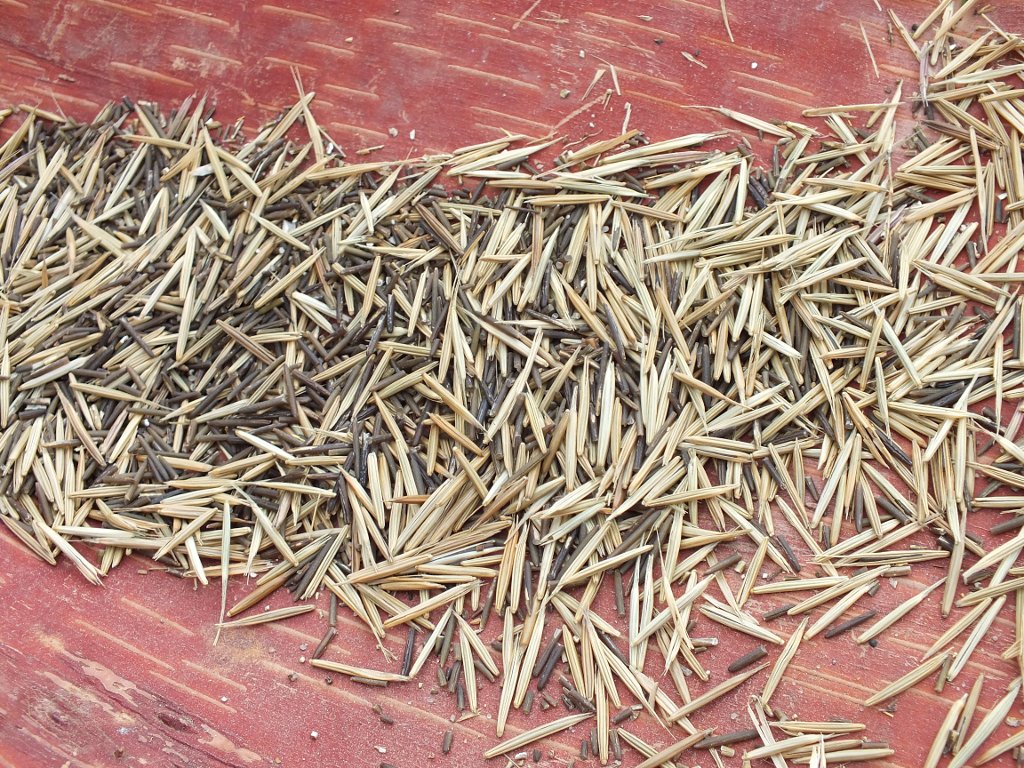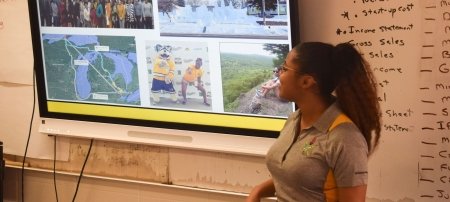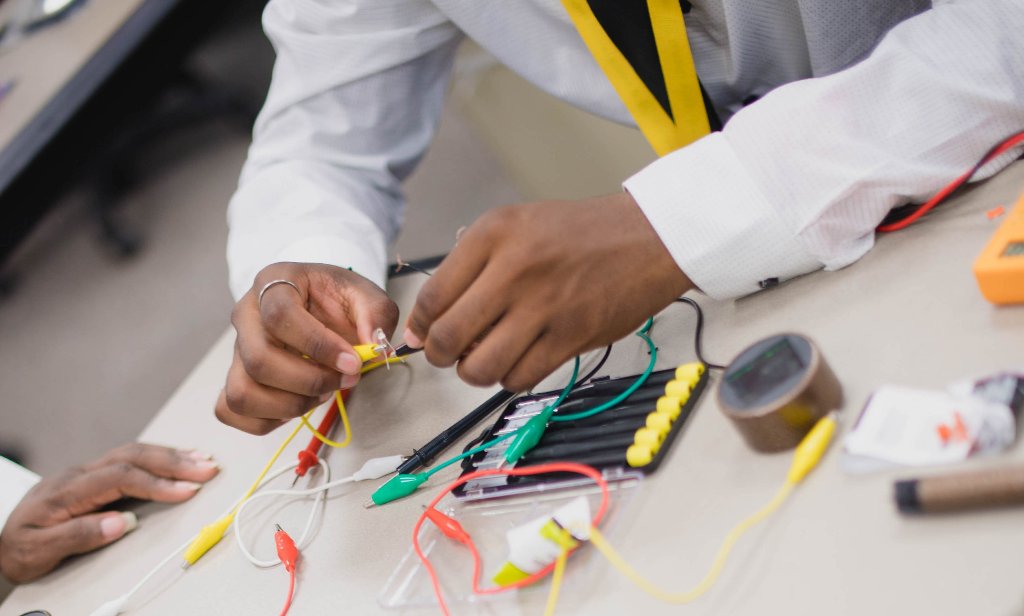In the season of feasting, summer-grown bounty graces northern tables as more than holiday plenty—it sustains the region's inhabitants through the winter, as it has through the centuries for the Anishinaabek. During the most recent harvest season, rice camp came to Michigan Technological University's Ford Forest Center to teach and share wild-ricing practices.

To the Indigenous settlers of this region, wild rice, known as manoomin, the good berry, is both a spiritual and nutritional staple. The food that grows on the water is revered as a gift from the Creator integral to their migration story, culture and traditions. Rice camps as much as possible create the feeling engendered in traditional camps, from the making and gathering of tools to the five-step harvest process. Historically, communities would relocate to the shores near rice stands, to harvest and process on site. It was part of the seasonal cycle. Rice camp teacher Roger LaBine of Lac Vieux Desert Band of Lake Superior Chippewa, near Watersmeet, Michigan, started harvesting in 1972 and has been involved with wild rice restoration since 1984. He first experienced the tradition with his uncle. "We would actually go camping on these lakes for a week to 10 days," he remembers. "We had to go all the way into Wisconsin to find rice. My uncle wanted it (wild rice restoration) for our community. We tried for over a decade."
Development, from agricultural runoff and industrial expansion to recreational activities, has threatened the sustainability of wild rice for decades. It's disappeared entirely in some areas. Expansion of hybridized varieties—much of the packaged wild rice in grocery outlets comes from large-scale commercial operations—delivers a one-two punch. Advocates responded on several fronts; including legislatively and legally. For example, Minnesota has an official wild rice harvesting season, from mid-August to late September. Wisconsin also has regulations in place. Michigan is unregulated and has no management plan, LaBine says, with the exception that river rice (Zizania aquatica), found in more southerly areas of the state, is listed as a threatened species. Michigan's only other wild rice species, found across the state, is the lake rice (Zizania palustris). It's not protected.
Tribes of the region, the Great Lakes Indian Fish & Wildlife Commission, conservationists and scientists are working toward management and restoration practices to ensure that native wild rice beds are here for future generations.
Wild Rice Restoration is a Grass Roots Effort
Wild rice is an annual aquatic grass—at times the plants masquerade as perennials, in stands that come back year after year, because it's continually reseeding itself. "One of the gifts the Creator gave it is it can remain viable for more than a year," LaBine says. Water-level fluctuations play a big role in cultivation and survival. It grows best in six inches to three feet of water. "It doesn't take much to make it too deep, or more favorable for other species," he notes.
Propagating the practice and understanding of manoomin cultivation is being accomplished through camps like the one at Ford Center, led by LaBine and Scott Herron. Herron, a professor of biology at Ferris State University, is of the Ojibwe Crane Clan, and like LaBine teaches at camps, classes and other outreach events. Both dedicated to their work with the Native Wild Rice Coalition, they've been doing rice camps together for eight years.
Crafting Harvest Tools
The Anishinaabek name monthly moon cycles for prevailing natural elements: the Wild Rice Moon (Manoominikegiizis) arrives in August. It is past peak time for gathering on this late September weekend, and an excessively rainy summer has affected this year's crop. But a tent shelters the campers as they whittle, sand, plane and shape pushing poles, rice knocking sticks and paddles, and joyful enthusiasm prevails.
The ground is carpeted with their handiwork: thin curls of fresh white cedar. The aromatic wood perfumes the air. "The tools are not many or complicated," says Great Lakes Indian, Fish & Wildlife Commission wildlife biologist Peter David, who attended camp with wife Lisa, a GLIFWC manoomin biologist. They've taken part in many harvests. "It's like being on a prairie, gathering grass seed," she says, as David smooths the edges of a parching paddle.
LaBine and co-teacher Herron have the easy way of moving from activity to activity that people do have who have run events together and have the flow down pat; helping with a sanding project here, finding out who wants to go out on the water tomorrow there, bantering with the many young people—including their own offspring, and students from Northern Michigan University's Center for Native American Studies.
"We've been following Roger's camps for quite some time," says center director April Lindala, a PhD candidate in rhetoric, theory and culture at Michigan Tech. "It gives students the opportunity for engagement with our communities."
Andrew Bek of Marquette came to rice camp because he's interested in growing it himself. "It's way more fun than buying it at the roadside stand," he says.
Rice campers learn the step-by-step basics of the harvest: pole, knock, parch, jig and winnow.

Five Steps from Lake to Harvest
Poling puts the tools camp participants created to use to propel canoes through rice beds. Push poles, which can be 16 feet or longer, are crafted for safety; not so long as to cause instability in the canoe as the craft moves easily with as little damage as possible through wild rice stands. "Poles are used instead of paddles to not break the stalks," says LaBine. "Once you break that stalk you're killing the seed head."
Knocking sticks are used to bump ripe spikelets into tarps on the canoe floor. They are used in pairs, and can be no longer than 39 inches and weigh no more than one pound total in states where that's regulated. White cedar is recommended. "There is an intentionality about why we use the wood. We don't use varnished paddles," Herron says.
"Parching transmutes the Manoomin medicine, still a living plant, into food," Herron explains. After it has air-dried for three to five days, the rice is placed in metal bowls over the fire; the white-cedar parching paddles are used to turn and flip the rice to keep it from burning. The rice will pop, like corn, if kept on the fire too long (a crunchy, nutty-tasting snack). But the intent is to parch just until the kernels are broken and so the rice-grains can emerge from their jackets.
Next come the jigging pits, and the rice dance that threshes the manoomin. Dancers wear clean moccasins. Socks can work in a pinch, if you don't mind ruining them and receiving the occasional poke from the pointy bits of rice and husk, says Herron, pulling out a pair he used for a spontaneous demonstration for some of his students.
Winnowing in tray-like birch bark containers with curved edges is has been compared to flipping a pancake, with wrist action that sends the dusty chaff into the wind, preferably away from the tosser. LaBine prefers a roller-coaster analogy to teach his students the motion. It's more about dropping the basket down to let the rice fall in, he says, like a roller-coaster car (the basket) plunging from the top of the ride's steepest incline while your stomach (the rice) stays somewhere up around your throat.
Sorting any other remaining material from the rice is a social event, a full circle of life's generations that draws the elders in to clean the rice, oversee the process and share their stories of harvests past.
Plant Wisdom, Harvest Wisely
Seeding is best done in the fall soon after harvest, but can begin after ice-out each year (although it is less successful). Techniques like encasing the seeds in mud balls and timing, transporting and planting within 72 hours, are used to help with establishment and yields. Asked if there is one method that yields a better crop than others, LaBine smiles.
I didn't leave one rock unturned in trying to improve success," he says. "The traditional way to do it is the right way." Camp includes teaching the ceremonies of gratitude and respect to spirit guides and the Creator, gifts of sacred tobacco—"it's part of learning that gratitude thing," says LaBine.
Hand-tossed rice seed is freely broadcast, but not the planting locations. There are long-standing practical reasons. Traditionally, rice accessible from shore is left for the littlest children to reap, where they can safely and more easily reach it.

"When you're knocking rice, you're also re-seeding it."
"We save for others: turtles, frogs, winged ones," says Herron. Manoomin is a favorite with ducks, swans and red-winged blackbirds, as well as moose and white-tailed deer.
A Community Makes Rice Camp Happen
Valoree Gagnon, a Michigan Tech postdoctoral researcher in social science, helped organize the event, which pulled together rapidly in the aftermath of a previous rice camp for youngsters. "More than 20 people—including staff, technicians and college interns—got to work creating the flyer and registration process, securing funds and in-kind donations, planning the menu, plus inventorying and collecting hundreds of tools, tarps, drills, processing equipment, and two dozen canoes, paddles and life jackets from upper and lower Michigan and Wisconsin. Some went to Minnesota to bring back more than 1,000 pounds of manoomin to seed in local waters," she says.
"Other volunteers collected forest materials. Michigan Tech forester Jim Schmierer gathered and transported several 15-foot hardwoods to Alberta. Alan and Canon Gagnon, alongside Keweenaw Bay Ojibwa Community College interns, located and sawed more than 30 'forks.' Pam Nankervis, of the US Forest Service, helped to find the much needed giizhik (cedar); Harry Miron and Clifford Nankervis each donated a truckload," she says. "These gifts led to the construction of more than 100 knocking sticks, parching paddles and push poles by camp participants."
"I acknowledge manoomin—for being in the heart of my friend Roger, for inspiring our partnership and the hard work of many, for teaching us the importance of gathering and harvesting together, and for reminding us to forge new friendships and to strengthen existing ones, with each other and our other-than-human relatives. For all these gifts, chi miigwech manoomin."
Michigan Technological University is an R1 public research university founded in 1885 in Houghton, and is home to nearly 7,500 students from more than 60 countries around the world. Consistently ranked among the best universities in the country for return on investment, Michigan's flagship technological university offers more than 120 undergraduate and graduate degree programs in science and technology, engineering, computing, forestry, business, health professions, humanities, mathematics, social sciences, and the arts. The rural campus is situated just miles from Lake Superior in Michigan's Upper Peninsula, offering year-round opportunities for outdoor adventure.







Comments